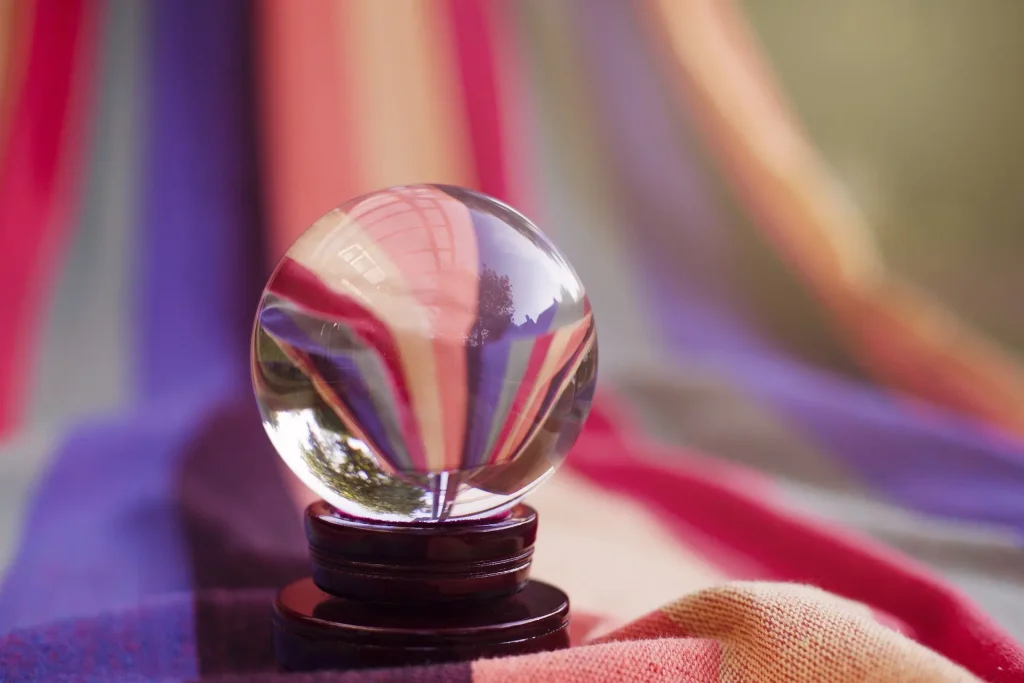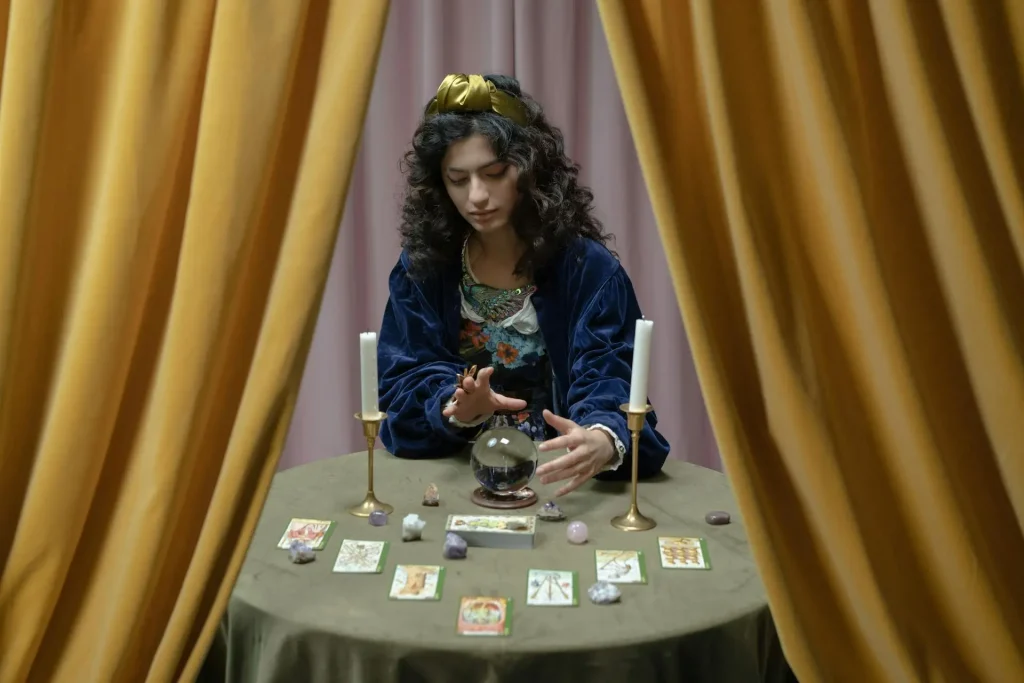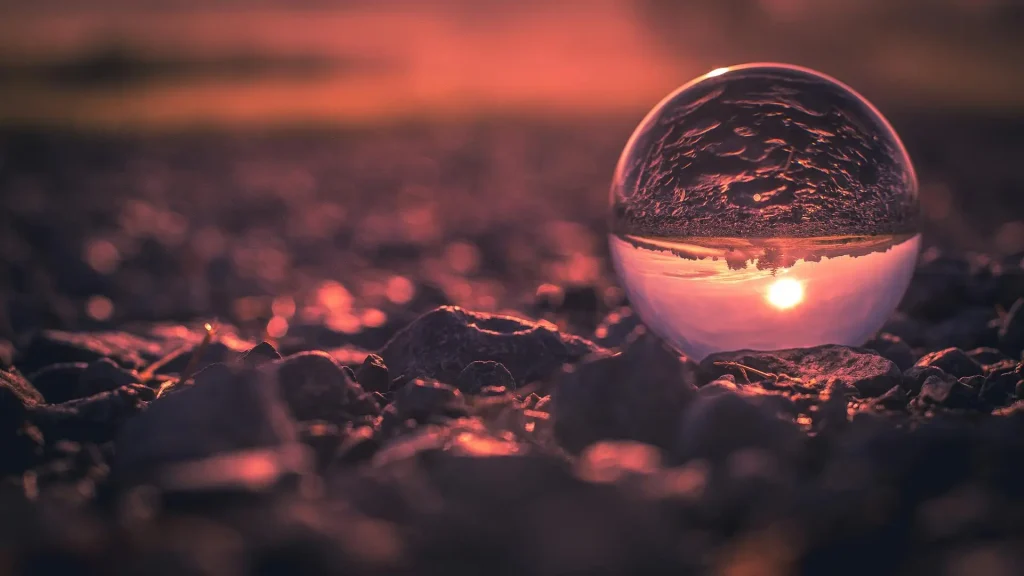Crystal ball knows it all…
It has been captivating people for centuries, serving as a mystical window into the unknown; being used for divination, meditation, spiritual practices, and more.
In this article, we’ll delve deeper into this magnificent object, providing you with more information on it.
Let’s take a look. 🧐

Image by Esi Grünhagen from Pixabay
Table of Contents
Historical Roots
The practice of divination, or seeking knowledge of the future through supernatural means, dates back to ancient civilizations. Among the earliest forms of divination was scrying, which involved gazing into reflective surfaces such as water, mirrors, or polished stones. These early practices laid the foundation for the later use of crystal balls as specific tools for scrying.
Their evolution can be traced to ancient Mesopotamia, where polished stones were used for divinatory purposes. During the medieval period in Europe, crystal balls gained prominence among alchemists and mystics. By the Victorian era, they had become a staple tool for spiritualists and psychics.
Composition and Characteristics
Crystal balls are typically made from a variety of crystals, with clear quartz and beryl being the most commonly used ones. Other materials include obsidian and glass.
Clear quartz, known for its clarity and light-diffusing properties, is particularly favored due to its purported metaphysical properties, and the ability to create mesmerizing visual effects. Beryl, another popular choice, is valued for its durability and the subtle color variations it offers.
The optical properties of a crystal ball are key to its function. The sphere acts as a lens, creating inverted and reversed images. This unique visual effect is believed by some to aid in accessing altered states of consciousness or perceiving hidden truths.
The ideal crystal ball is perfectly spherical, as this shape allows for the even distribution of light and energy, enhancing the scrying experience. It is free from any imperfections, typically ranging from 2 to 8 inches (around 5 to 20 cm) in diameter. Many practitioners prefer a diameter of 4 to 6 inches (around 10 to 15 cm), which is manageable for personal use yet large enough to produce clear images.
The Practice of Crystal Gazing (Scrying)
Crystal gazing, also known as scrying, is an ancient technique used to gain insight into the past, present, or future. The process involves entering a meditative state and gazing into the crystal ball to perceive visions, symbols, or messages.
Practitioners often prepare a quiet, dimly lit environment to enhance focus. Some use candles or incense to create a specific atmosphere that makes the meditation process easier. The crystal ball may be held or placed on a stand.
When it comes to the scrying process itself, the practitioner is focusing their gaze on the crystal ball until their mind enters a trance-like state. They look for symbols, shapes, or visions within the crystal, interpreting them based on intuition (their meanings can vary based on the context of the reading and the individual’s psychic abilities) or established systems of symbolism. Some report seeing moving images, while others perceive still scenes or abstract patterns.

Photo by cottonbro studio
Cultural Significance
Crystal balls have played significant roles in various cultures. In Celtic traditions, they were associated with druidic practices, where seers used them to communicate with the spirit world. In Chinese culture, they were often used in feng shui practices to harmonize the energy within a space.
In Western culture, they’ve become synonymous with fortune-telling and mysticism, frequently appearing in literature, films, artwork… Famous practitioners include figures like Jeane Dixon, one of the best-known American psychics and astrologers, and John Dee, the advisor to Queen Elizabeth I, who used a crystal ball for scrying and communication with angels.
Scientific Perspective
From a scientific standpoint, the visions reported by crystal ball users can be explained through psychological phenomena. Pareidolia, the tendency to perceive meaningful patterns in random stimuli, likely plays a role. Similarly, suggestibility and the power of expectation can lead individuals to see what they anticipate or desire.
The optical properties of crystal balls, such as light refraction and reflection, coupled with the brain’s interpretive processes, can create interesting visual effects that contribute to the experience of scrying.
Modern Uses and Adaptations
Today, crystal balls continue to be used in various forms of fortune-telling and spiritual practices. They are also popular as decorative items, with many people appreciating their aesthetic appeal and the sense of mystery they evoke. Collectors seek out rare and unique crystal balls, often valuing them as much for their beauty as for their historical or spiritual significance.
Some contemporary practitioners use them in meditation or energy work, viewing them as tools for focus and self-reflection rather than strictly for divination.
In the digital age, they have even found their way into virtual and augmented reality applications, where they are used in games, apps, and online readings, bringing the ancient practice of scrying into the modern world.
Controversies and Skepticism
Despite their enduring appeal, crystal balls have also been the subject of controversy and skepticism. Crystal ball reading is often dismissed by critics as pseudoscience, stating that any perceived accuracy in readings stems from cold reading techniques or the Barnum effect, where vague statements are perceived as personally significant.
So, skeptics point to the lack of empirical evidence supporting the efficacy of crystal ball gazing, and suggest that any insights gained are more likely a result of psychological factors than any supernatural power.
Furthermore, legal issues have arisen around crystal ball reading, with some jurisdictions requiring fortune-tellers to present their services as entertainment rather than genuine prediction.

Photo by Paul Basel
Care and Maintenance
For those who own and use crystal balls, proper care and maintenance are essential. This includes regular cleaning (with a soft, lint-free cloth) to remove fingerprints and dust, which can affect the clarity of the ball. Storing it in a safe, padded environment is also important to prevent any damage.
Many practitioners also engage in energetic cleansing rituals (believing that it helps to clear the ball of any negative energies or residual influences from previous readings), such as placing the ball in moonlight or using sage smoke, believing that that maintains the ball’s metaphysical properties.
___________
That would conclude our introduction to crystal ball. Thank you so much for reading!
What’s your opinion on it? Do you have any experience with crystal balls?
Feel free to let us know in the comments below!
___________
More Articles:
- The Pentagram: History, Symbolism, and Modern Interpretations
- Cetus – The Forgotten 14th Zodiac Sign
- Hybrid Starseed: Mixed Cosmic Heritage and Unique Traits
- Owl Symbolism: Discovering Hidden Wisdom in the Dark
